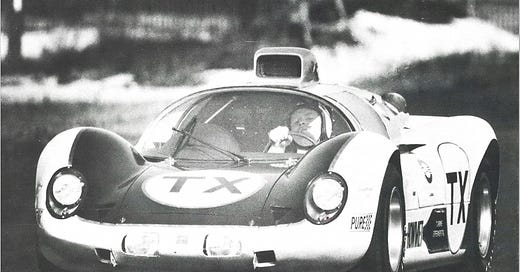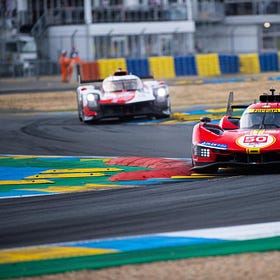The Howmet TX and the Summer Of '68
The turbine engine-powered Howmet TX had a short but memorable run in 1968.
Winning races at two long-forgotten tracks on back-to-back weekends is hardly the stuff of a golden era. In the case of the Howmet TX, however, four wins in four outings in June 1968 is as good as it got--and it was pretty good.
“To Howmet Corp, a major producer of gas turbine parts, the two cars are used mostly for corporate image building,” Michael Yaffee wrote in his July 1968 Aviation Week & Space Technology magazine cover story prompted by the TX and several other turbine-engine automotive applications being tested at the time. “However, they also happen to be the only turbine-powered cars that have ever won a race.”
Motorsport's historical chronicles show they still are--at least in a notable, points-paying series.

The Howmet TX was the brainchild of race car driver/engineer Ray Heppenstall. It wasn't the first turbine-powered car--a Rover BRM ran and finished the 24 Hours of Le Mans in 1963 and 1965. But it was arguably the most successful.
Heppenstall and Tom Fleming, a racing friend and the vice president of sales for Howmet, thought a small, lightweight turbine engine placed in a bespoke chassis could give conventional cars a run for their money. The program could also be a valuable promotional tool for Howmet--or so Fleming told his bosses.
They signed on, and in 1967 the Howmet TX project started.
The biggest step in the car-development process was finding a suitable motor. As fortune would have it, their future race-winning engine started out as a loser.
Continental Aviation & Engineering developed an engine, the TS325-1, for a U.S. Army scout helicopter competition. But when a competing motor made by Allison won the battle, the handful of engines Continental developed as part of its bid suddenly had no purpose.
Enter the Howmet TX.
The engine's smaller size helped the car fit into the Fédération Internationale de l'Automobile (FIA) Group 6 sports car category. (The Allison engine was too large for FIA competition.) McKee Engineering built the chassis. Howmet didn't just back the project--it supplied several key parts, including aluminum for the body, engine turbine blades, and titanium brake components.
The TX made its debut in the February 1968 24 Hours of Daytona, with Heppenstall, accomplished sports-car racer Dick Thompson, and Ed Lowther, a home builder and "gentleman" driver, sharing the driving. The car ran as high as third overall before retiring with a mechanical issue.
Next up was the 12 Hours of Sebring, where the car qualified third, but again dropped out due to a mechanical failure.
Two races in Europe brought two more early retirements.
Back in the U.S., Sports Car Club of America-sanctioned stops in Huntsville, Alabama and Upper Marlboro, Maryland (where legend Jackie Stewart earned his first win on U.S. soil in a 1964 12-hour event) were more favorable.
During the weekend of June 8, Heppenstall won both his qualifying race and the main event at Huntsville. A week later, driving the second TX chassis, he won the qualifying tilt at Marlboro. Sharing driving duties with Thompson in the next day’s feature, Heppenstall and the TX took the main event, too.
Those wins prompted the team to head to Watkins Glen for the annual 6-hour FIA race in July, taking both cars for the first time since Daytona (where only one started). Both ran well until technical issues forced them to drop out late. But that was enough to convince the team to enter the 24 Hours of Le Mans, moved from its traditional June date to September due to French labor unrest.
Both cars struggled from the start. The Thompson/Heppenstall entry's engine was never at full power. They pressed on, but were done when Thompson rolled the car at Le Mans' famed Indianapolis corner. He walked away.
The other TX, driven by Hugh Dibley and Bob Tullius, suffered a wheel bearing problem and retired less than a third of the way into the 24 hours.
Le Mans would be the last competitive outing for the Howmet TX, as the company opted to end the race program after the 1968 season. The cars hung around for promotional purposes, however, and two similar ones were later built for enthusiasts using surplus chassis and parts.
Only the original Howmet TX chassis has a Continental engine, however. Concerns over spare parts led the others to use a version of the original Allison motor that became the Allison 250--one of most successful aviation engines ever built.
The Continental and Allison specs may be different but the Howmet TX’s unmistakeable turbine-engine whine--still heard on rare occasions at classic motorsport events--will never change.
More from On Motorsport
A Swap for the Ages
In a weekend full of memorable moments, Bob Wollek's mid-race mini-diatribe for the TV cameras may have topped the list. "He doesn't know the car, he doesn't know the rain," Wollek complained to legendary driver-turned-broadcaster David Hobbs. "He doesn't know anything."
Clashes of the Titans
Sports-car endurance races aren't decided in the first hour, let alone on the first lap. Every once in a while, however, their tone can be set early--even at the first corner. Seconds after the 62-car field crossed the start-finish line to begin the 2023 24 Hours of Le Mans, Sébastien Buem…
References
Aviation Week & Space Technology excerpts, engine competition—https://archive.aviationweek.com/issue/19680729#!&pid=54
Howmet TX race results--https://bpmc.org.uk/petestowe/HowmetTX.htm
Stewart wins at Marlboro—https://www.nytimes.com/1964/08/17/archives/british-team-of-lotuscortinas-finishes-1-2-in-12hour-marlboro-car.html
Howmet TXs today--http://wsrp.ic.cz/chassis/chassis_mckee.html






